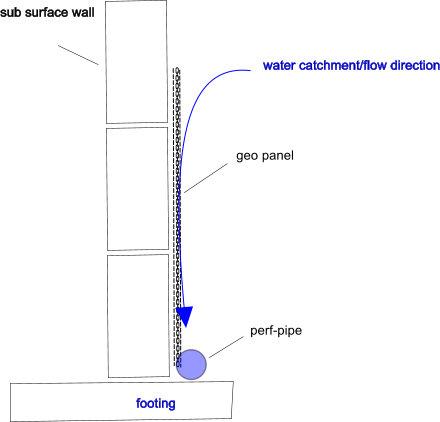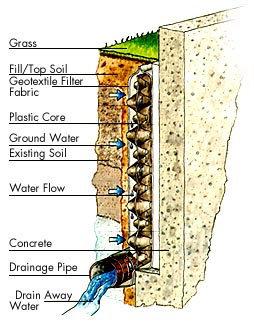- Joined
- 6 Oct 2010
- Messages
- 26
- Reaction score
- 1
- Country

My property is on a gentle north slope, with a paved patio on the south side (added, I believe, after construction), the patio area is ~10 x 5m.
View media item 59971
During particularly heavy rain, the south wall (which can be seen from the crawl space) becomes saturated up to the DPC, and rainwater trickles through it into the crawl space where it soaks into the ground. Puddles also form outside the house, at the east end of the drain where the downpipe joins it; this section flows freely.
The ground floor is made of 20cm slabs of reinforced concrete (a bit like Ytong with rebar). There's no damp problem within the house, but the drain clearly isn't functioning.
View media item 59973
Taken after removal of uppermost layer of large rocks, photo shows there's no screening material at all, and soil pervades the whole volume. The pipe itself is resting on the footing.
NB: I'm not trying to tank/waterproof anything - if there's a little moisture (not running water!) in the crawlspace, then fine (I think).
But, I am confused by conflicting info/advice:
1) Should the drain be on top of the footing, or next to it?
View media item 59970According to the attached diagram, there are a number of approaches, but which to choose? What are the dis/advantages of each?
2) How is one supposed to achieve the recommended slope if resting on a horizontal footing? If laying adjacent to footing, same problem: one must start higher, or end below footing level.
3) If the patio was added following construction, is it possible that the original drain's capacity is too small for the fast-flowing surface it's draining? Is there some formula for calculating capacity?
4) Some sources state that the drainage holes/slots should be face up, and others the opposite (including the diag in the album). How to decide?
View media item 59972
My current thinking:
- install a drainage membrane (Isostud or similar) against the wall and footing
- position correct-sized pipe adjacent to the footing
- fill appropriately, including filter material
Am I on the right track? What's the best approach?
Best wishes,
autopoiesis
edit: images
View media item 59971
During particularly heavy rain, the south wall (which can be seen from the crawl space) becomes saturated up to the DPC, and rainwater trickles through it into the crawl space where it soaks into the ground. Puddles also form outside the house, at the east end of the drain where the downpipe joins it; this section flows freely.
The ground floor is made of 20cm slabs of reinforced concrete (a bit like Ytong with rebar). There's no damp problem within the house, but the drain clearly isn't functioning.
View media item 59973
Taken after removal of uppermost layer of large rocks, photo shows there's no screening material at all, and soil pervades the whole volume. The pipe itself is resting on the footing.
NB: I'm not trying to tank/waterproof anything - if there's a little moisture (not running water!) in the crawlspace, then fine (I think).
But, I am confused by conflicting info/advice:
1) Should the drain be on top of the footing, or next to it?
View media item 59970According to the attached diagram, there are a number of approaches, but which to choose? What are the dis/advantages of each?
2) How is one supposed to achieve the recommended slope if resting on a horizontal footing? If laying adjacent to footing, same problem: one must start higher, or end below footing level.
3) If the patio was added following construction, is it possible that the original drain's capacity is too small for the fast-flowing surface it's draining? Is there some formula for calculating capacity?
4) Some sources state that the drainage holes/slots should be face up, and others the opposite (including the diag in the album). How to decide?
View media item 59972
My current thinking:
- install a drainage membrane (Isostud or similar) against the wall and footing
- position correct-sized pipe adjacent to the footing
- fill appropriately, including filter material
Am I on the right track? What's the best approach?
Best wishes,
autopoiesis
edit: images


